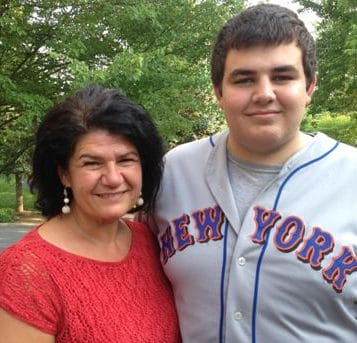 Natasha Ednan-Laperouse
Natasha Ednan-Laperouse Many in the food allergy community have been following the British inquest into the anaphylaxis death of Natasha Ednan-Laperouse. In four days of testimony, we learned the heartbreaking confluence of events that led the 15-year-old to pass away following a severe allergic reaction to sesame on a flight from London to Nice, France, in the summer of 2016.
The details revealed at the inquest were dreadful for the Ednan-Laperouse family to relive, but also deeply concerning for many food-allergic travelers worldwide. As someone who advocates for better allergy accommodations and as the mother of a food-allergic son, I now know more than ever that there is an urgent need for better airline crew training to be ready – in the event of anaphylaxis.
The Sept. 28, 2018 conclusions of Coroner Dr. Sean Cummings focused on the need to tighten labeling shortcomings, which led Natasha and her father Nadim Ednan-Laperouse to presume her sandwich was sesame-free when it was not.
But during the inquest, evidence also showed there was not sufficient understanding of anaphylaxis among this particular British Airways crew. Nor was there appreciation that epinephrine is not always a miracle antidote, especially if it hasn’t been administered promptly after eating an allergen. There were also issues with how the crew supported the young physician who came forward to help Natasha on that fateful trip on July 17, 2016. My concern is less with this one crew, and more with how this case points, in general, to shortcomings in allergy readiness in the air.
Let’s consider the actions that unfolded aboard this flight and where they are troubling:
- During the inquest, the flight’s crew manager, Mario Ballestri, said Ednan-Laperouse told him 30 minutes before landing that his daughter was suffering an allergic reaction to a sandwich she’d eaten, and he was going to give her an EpiPen auto-injection (the first of two he would give). According to the BBC’s Dan Johnson, Ballestri testified that he’d heard of such an injection being like a “miracle cure,” so he expected the teen’s condition would improve. As we know from other tragedies, epinephrine works more successfully when given early in a reaction (before it becomes systemic), but even then is never a guarantee.
- Ballestri said he went to the cockpit to inform Captain Richard Hunter of the reaction and suggested contacting the MedLink advisory service. Alarmingly, the inquest heard that MedLink was not contacted, as there was no satellite phone on this flight, only a long-range radio. The BBC’s Johnson says Hunter testified that he thought MedLink would simply advise on the state of the emergency and offer advice on whether to divert. While that is part of its role, MedLink does far more – it puts airline crews in touch with medical experts to offer advice on treating specific patient conditions. This crew didn’t get the benefit of such advice.
- Dr. Thomas Pearson-Jones, a young doctor who’d graduated just the day before, came forward to help. Coroner Cummings praised his work. But The Guardian quotes the coroner saying during the hearing: “I’m struggling a little bit with why the full range of [medical] kit wasn’t made aware to Dr. Pearson-Jones.” This was in reference to the fact that the BA crew had not retrieved the defibrillator from the rear of the plane while the doctor was giving Natasha CPR at the front, nor did he get help to locate other epinephrine in the emergency medical kit.
- As someone who has advocated for critical need for epinephrine auto-injectors in medical kits, I was struck by the fact that after her father had administered Natasha’s two auto-injectors, the doctor asked two crew members to prepare additional adrenaline (or epinephrine) injections from the vials in the emergency medical kit. The crew members said they were not trained to draw up syringes – so the vials of potentially life-saving adrenaline remained untouched.
As well, The Guardian quoted crew manager Ballestri saying there likely was an EpiPen auto-injector in the medical kit. However, no crew member informed the doctor. Ballestri agreed he should have mentioned it, “but I was just following the doctor’s requests.”
- Sky News reporter Joe Tidy reported that an allergist who testified as an expert witness was asked if Natasha could have survived had she received additional epinephrine onboard the plane. The doctor couldn’t say for certain, but added: “It would have improved her treatment and may have lengthened [her survival] time.”
- That’s a chilling thought, and so is this – the BBC’s Johnson says the captain, the key to all decision-making on a flight, was not aware that, as he was descending into Nice, Natasha had suffered cardiac arrest. He didn’t know this until the plane was on the ground and paramedics rushed his critically ill passenger to hospital.
- According to a Sky News report, the coroner said it was an omission that the BA crew didn’t inform the doctor there was a defibrillator at the other end of the plane, so he could have made a call as to whether it would be helpful. By the time Natasha had suffered cardiac arrest (which can occur with severe anaphylaxis), the plane was in its landing approach. The crew were told to take their seats, to comply with air safety regulations. An allergist told me this week that it’s difficult to say whether the device would have helped in this situation. However, this we know: doctors working in urgent situations need to know of all the tools available.
 Natasha with her father Nadim Ednan-Laperouse. Photo: Family Handout
Natasha with her father Nadim Ednan-Laperouse. Photo: Family Handout Clearly, it is time to reassess airline readiness for anaphylaxis. This much is clear to me from Natasha’s tragedy as well as from testimonies I have collected on No Nut Traveler: Many airlines’ staff do not fully grasp the severity and limitations of treatment of an anaphylactic reaction at 30,000 feet in the air.
Flight attendants are already highly trained individuals who can use a defibrillator. They need a few more tools to assist a person such as Natasha: this starts with having epinephrine auto-injectors readily available in the emergency kit, since anaphylaxis is a swift-progressing condition that needs to be treated early.
Now let me state another need: In this modern world of numerous food allergies and the need for travel, it is time to create a standard international airline anaphylaxis action plan. Such a plan should be developed to train crew on how to recognize the symptoms of a severe allergic reaction and how to treat it, including how to administer an auto-injector. They also need to learn a few critical pieces that so many miss:
- Time is of the essence. Anaphylaxis is a swift-progressing condition that needs to be treated early.
- While dire reactions are rare, they happen. Several doses of epinephrine may be required, once such a reaction is in progress.
- Positioning of the person with anaphylaxis may be important. As the U.K. not-for-profit the Anaphylaxis Campaign notes in its emergency instructions, when a person suffering a severe allergic reaction is feeling weak or dizzy, that person should be lying down, with legs raised to help blood flow.
To those who would argue it’s not feasible to stock all airlines with auto-injectors and train all crew, let me point to Australia. In this country known for its high rate of food allergy, all airlines now carry both adult and youth-size epinephrine auto-injectors and have food allergy action plans in onboard airline manuals, plus anaphylaxis training conducted by nurses. If there is a will, it can be done.
Food allergies are now a worldwide public health concern. It’s time we faced the realities of preventing life-threatening anaphylaxis in the air, and the necessity for easy-to-use auto-injectors and crew training. But I will not lie: I am heartbroken that it takes the death of a lovely teen like Natasha to prompt meaningful discussion. Nadim Ednan-Laperouse said the inquest into his daughter’s death should “serve as a watershed moment to make meaningful change and save lives.” I hope this is true, both on the ground and in the air.
Lianne Mandelbaum is the founder of NoNutTraveler.com.
Day 1 of inquest: Teenager’s Fatal In-Flight Reaction Raises Food Allergy Labeling Loophole
Day 2 of inquest: Chain Knew of 21 Reactions to Its Food in Year Before Teen’s Fatal In-Flight Reaction
Day 3 of inquest: Airline Crew Did Not Use Defibrillator on Teen Who Had In-Flight Anaphylaxis
Findings of inquest: Coroner Finds Inadequate Allergy Labeling Led to Teen’s Death





